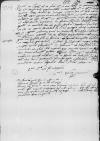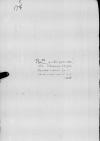List #2136
Ioannes DANTISCUS do Tiedemann GIESEHeilsberg (Lidzbark Warmiński), 1539-04-25
Regest polski:
Dantyszek, powróciwszy poprzedniego dnia z Zyborka, zastał posłańca z listem księcia [Albrechta]. Na prośbę nadawcy przesyła ten list Giesemu do przeczytania. W odpowiedzi zapewnił księcia, że Rada [Pruska] dołoży starań, by w czasie sejmu [pruskiego] zajęto się opisanymi w liście sprawami.
Dantyszek nie ma nic przeciwko temu, by Giese napisał [do Albrechta], co uzna za stosowne, uważa jednak, że w obliczu bezpośredniego zagrożenia liczyć mogą jedynie na Bożą pomoc, nie zaś na rady i pomoc z zewnątrz.
Dantyszek napisał do rady Elbląga i rady Gdańska, by zawiadomiono zainteresowanych o przeniesieniu sejmu. Obiecuje przesłać nowiny, gdy tylko jego poseł powróci z dworu.
W postscriptum Dantyszek przeprasza, że zbyt wysoko umieścił podpis pod listem, sądzi jednak, że Giese nie weźmie mu tego za złe, skoro sam niekiedy tak czyni. Zapewnia o niezmienności swojej przyjaźni dla Giesego.
Rękopiśmienne podstawy źródłowe:
Pomocnicze podstawy źródłowe:
Publikacje:
| ||||||||||||||
Tekst + aparat krytyczny + komentarzZwykły tekstTekst + komentarzTekst + aparat krytyczny
Reverendissimo in Christo Patri Domino, domino
Reverendissime in Christo Pater et Domine, frater et amice carissime et honorande.
Salutem ex animo pristinamque incolumitatem a Domino Deo Dominationi Vestrae Reverendissimae intime precor.
1539-04-24⌊Heri1539-04-24⌋ rediens ex
Ceterum, quemadmodum nuper attigi, cf.
Cui iterum atque iterum prosperam summopere opto valetudinem.
Ex
Reverendissimae Dominationis Vestrae frater integerrimus
Postscript:
Debueram me paulo inferius, ut consuevi, subscribere, quod certe mihi exciderat, non tamen Dominationem Vestram Reverendissimam aegre laturam existimo, cum ad eum modum ipsa eiusmodi subscriptione subinde utatur. Hoc igitur adnotavi, ne putet ob id quicquam ex coeptae inter nos amicitiae observantia decessisse etc.[2]
[1] Dantiscus uses the past tense here in regard to his letter to
[2] At the time the issue of where to place the subscription in the letter was discussed by Joan Luis Vives in his treatise cf. Juan Luis Vives, De conscribendis epistolis : critical edition with introduction, translation, and annotation, ed. by Charles Fantazzi, Brill, 1989, series: Selected Works of Juan Luis Vives 3 , p. 70⌊De conscribendis epistoliscf. Juan Luis Vives, De conscribendis epistolis : critical edition with introduction, translation, and annotation, ed. by Charles Fantazzi, Brill, 1989, series: Selected Works of Juan Luis Vives 3 , p. 70⌋.


 BCz, 245, p. 178
BCz, 245, p. 178